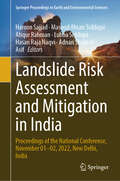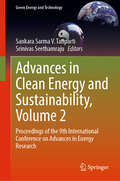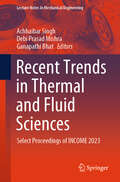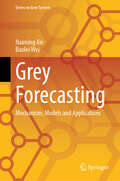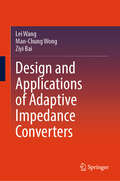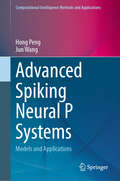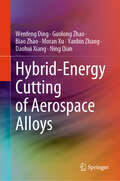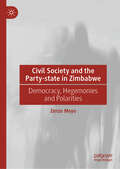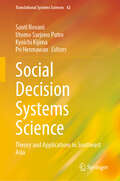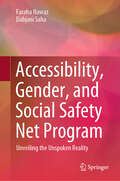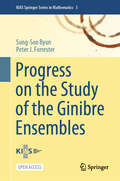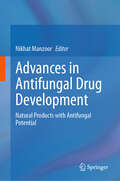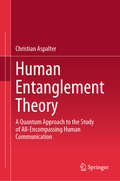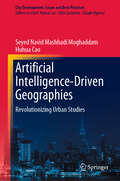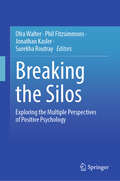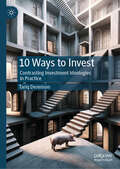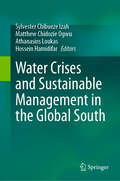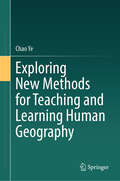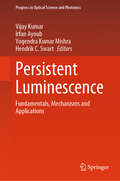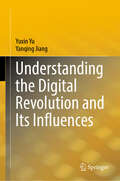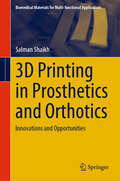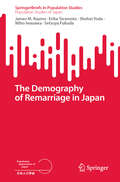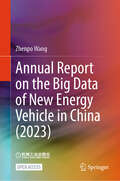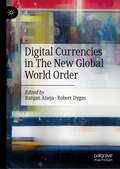- Table View
- List View
Landslide Risk Assessment and Mitigation in India: Proceedings of the National Conference, November 01-02, 2022, New Delhi, India (Springer Proceedings in Earth and Environmental Sciences)
by Haroon Sajjad Atiqur Rahman Lubna Siddiqui Masood Ahsan Siddiqui Hasan Raja Naqvi Adnan Shakeel AsifThis book focuses on landslide hazard mapping, identification of site-specific drivers of landslide occurrence, and assessment of landslide susceptibility, vulnerability, risk and mitigation using advanced techniques and approaches. The book encompasses the use of geospatial technologies, artificial intelligence, machine learning algorithms, and advanced statistical models to explore multi-dimensionality of landslide hazard. The book is a synthesis of research papers presented at the National Conference on Landslide Risk Assessment and Mitigation in India, organized by the Department of Geography, Jamia Millia Islamia, New Delhi, India, 01–02 November 2022. The book is organized into four parts made up of 21 chapters. Part I deals with landslide hazard mapping. Part II covers landslide susceptibility mapping and assessment. Part III evaluates landslide risk. Finally, Part IV presents multi-disciplinary approach and holistic mechanism to devise landslide mitigation strategies. The chapters help better understand the intertwined physical processes, causes of landslides, potential risk factors, movement characteristics, and role of engineering and technology to minimize upcoming human, physical and economic losses. The book is a valuable resource for researchers, academicians, stakeholders, and policy makers.
Advances in Clean Energy and Sustainability, Volume 2: Proceedings of the 9th International Conference on Advances in Energy Research (Green Energy and Technology)
by Sankara Sarma V. Tatiparti Srinivas SeethamrajuThis book presents the proceedings of the 9th edition of the International Conference on Advances in Energy Research (ICAER 2023) and delves into the research trends of energy systems in terms of generation, storage and distribution so they can become more sustainable in the future. The topics covered include conventional, non-conventional and renewable energy technologies, energy storage and conversion, energy policy, energy economics, energy efficiency and management, electric vehicles and smart grids and the social and environmental aspects of energy. The topics presented in the book are a combination of experimental and modeling studies which include simulation, design and optimization of the systems. This proceedings volume is a compendium of the latest advances in energy research for scientific researchers, policymakers, academicians, and industry experts. It is also expected to benefit economists, rural activists, and social scientists, among others.
Why is Social Justice Possible?: Social Justice Issues during China’s Period of Transition
by Zhongmin WuThis is an open access book. This OA book contains extensive research on social justice during China’s transition period. Rather than taking a macro-historical approach, or looking at social justice from a philosophical perspective, the book focuses on relevant theories and justice at a meso-level. It looks at the basis for social justice, and details the basic values and the basic standpoints when it comes to social justice. It differentiates between the concepts of justice, righteousness, fairness and equality. It then lays out three social justice rules (related to equal opportunities, distribution and social adjustment), and discusses the ideas of intergenerational justice and procedural justice. The book looks from a sociological point of view at social justice during China's period of transition. It focuses on how certain rules affect the social strata, and how they lead to discrimination, inequalities, liberty, equality, universal justice and/or differential justice. This book assesses improper pursuits of social justice in China. It also looks at how the ideas of liberty and equality have evolved, and some of the key problems over the last 70 years. This book also explains some of the more popular social topics that foster empirical discussions. Since the reform and opening-up era, China has made great achievements when it comes to social development. The country has made notable progress with social justice. There are more equal opportunities than ever before. Nevertheless, there remain worrying problems when it comes to the idea of justice. To some extent, these problems offset the achievements. In some form, the development processes have been somewhat misguided, and these have had a negative impact on Chinese society and how it functions and develops. Therefore, this book is of theoretical and practical significance when it comes to social justice research.
Recent Trends in Thermal and Fluid Sciences: Select Proceedings of INCOME 2023 (Lecture Notes in Mechanical Engineering)
by Debi Prasad Mishra Achhaibar Singh Ganapathi BhatThe book presents select proceedings of the International Conference on Mechanical Engineering (INCOME 2023). It presents the topics related to thermal and fluid mechanics including various sources of energy. The topics covered include theoretical and practical aspects of thermal and fluid systems and thermal design of the related equipment. The book also includes latest topics such as solar energy, computational techniques, enhancement of energy storage capacity, fluid solid interaction, and hybrid energy systems. The book is a valuable reference for beginners, researchers, and professionals interested in research, design, and development in thermal and fluid sciences.
Grey Forecasting: Mechanism, Models and Applications (Series on Grey System)
by Naiming Xie Baolei WeiThis book aims to present an overview of grey system models for time series modelling and forecasting. It is about modelling and forecasting time series with ordinary differential equations, especially when the available samples are extremely limited. Grey system models (GSM) develop sequence operators to nonparametrically identify the underlying dynamics from the limited observations. This book concerns about two important modelling themes, small sample and poor information. The former focuses on the mechanism and methodology of GSMs for small-sample real-number time series, and the latter on the uncertainty quantification of grey number together with its small-sample modelling principles. In this book, a broad entry point to applied data science for students majoring in economic, management science, and engineering is applied, covering a wide range of topics from basic introductory material up to research-level techniques.
Design and Applications of Adaptive Impedance Converters
by Lei Wang Man-Chung Wong Ziyi BaiThis book provides the potential advantages of adaptive impedance converters in different applications, such as power quality compensations, AC/DC microgrids, co-phase railway traction supply systems, and underwater electroacoustic transduction systems. In these applications, the adaptive impedance converter models, topologies, and control methods are introduced in this book. Adaptive impedance converters are designed to transform the impedance of an electronic system to optimize its performance. The adaptive impedance converter is typically implemented using passive and active electronic components to achieve impedance transformation. The main advantage of adaptive impedance converters is their ability to dynamically adjust the impedance to optimize system performance, which can help improve signal quality, reduce interference, and minimize power losses. Whether it is passive based adaptive impedance converters and active adaptive impedance, they both can applied into different applications including distribution system, renewable energy integration, AC/DC microgrids, traction supply system, and power amplifiers to achieve good performances and ensure efficient power transfer. The passive-based adaptive impedance converters can effectively reduce the converter rating and power loss, maintaining a large operational range. The active adaptive impedance can change its impedance varying with frequency, load conditions, or other factors to match the impedance of the source or load, providing efficient power transfer and minimizing signal reflections. The target audience of this book is the research scholars (including master’s and Ph.D. students) in power electronics and electrical engineer.
Advanced Spiking Neural P Systems: Models and Applications (Computational Intelligence Methods and Applications)
by Jun Wang Hong PengMembrane computing is a class of distributed and parallel computing models inspired by living cells. Spiking neural P systems are neural-like membrane computing models, representing an interdisciplinary field between membrane computing and artificial neural networks, and are considered one of the third-generation neural networks. Models and applications constitute two major research topics in spiking neural P systems. The entire book comprises two parts: models and applications. In the model part, several variants of spiking neural P systems and fuzzy spiking neural P systems are introduced. Subsequently, their computational completeness is discussed, encompassing digital generation/accepting devices, function computing devices, and language generation devices. This discussion is advantageous for researchers in the fields of membrane computing, biologically inspired computing, and theoretical computer science, aiding in understanding the distributed computing model of spiking neural P systems. In the application part, the application of spiking neural P systems in time series prediction, image processing, sentiment analysis, and fault diagnosis is examined. This offers a novel method and model for researchers in artificial intelligence, data mining, image processing, natural language processing, and power systems. Simultaneously, it furnishes engineering and technical personnel in these fields with a powerful, efficient, reliable, and user-friendly set of tools and methods.
Hybrid-Energy Cutting of Aerospace Alloys
by Guolong Zhao Wenfeng Ding Biao Zhao Ning Qian Moran Xu Yanbin Zhang Daohui XiangThis book pioneers the exploration of hybrid-energy cutting for aerospace alloys, summarizing cutting-edge research on laser-assisted, ultrasonic vibration-assisted, electrical-assisted, and hybrid-energies-assisted cutting. It also covers enhanced heat transfer in cutting processes, proposing novel technologies for achieving geometric precision and surface integrity at low costs. The book delves into multi-energy fields interaction mechanisms, material removal, tool wear, and cutting performance of aerospace alloys, alongside green and high-efficient cooling technologies. Targeting researchers, scientists, engineers, and professionals in aerospace, materials science, mechanical engineering, and manufacturing, this advanced-level resource assumes a solid background in engineering and materials science. It provides detailed discussions on theoretical aspects and practical applications of hybrid-energy cutting techniques. This book is a valuable reference for advanced researchers and practitioners in aerospace alloys cutting. It provides a comprehensive exploration of hybrid-energy technologies, detailed insights into mechanisms and performance, and a focus on sustainable and cost-effective cutting solutions.
Civil Society and the Party-state in Zimbabwe: Democracy, Hegemonies and Polarities
by Zenzo MoyoThe book utilises Gramsci’s concepts of hegemony, counter-hegemony, organic intellectuals, and integral state to interrogate how modes of engagement between the state and civil society have contributed to a polarised polity in Zimbabwe, and in turn how this has impacted democratisation processes. This was achieved by analysing intra-civil society interactions and state-civil society relations, which established deep polarised relationships that can be traced back to the liberation struggle. It also interrogates ideologies that drive these polarised relations, and how, together with material benefits from donors and the party-state, these relations impact ordinary people’s modes of existence. One of the arguments that emerge from the book is that political polarisation in Zimbabwe has now morphed into an established political culture that has played a huge role in the retardation of democratic struggles. It uses ideas of entangled modernities and travelling theory to cast doubt on the belief that civil society is the ‘missing key’ in the democratisation of developing countries.
Social Decision Systems Science: Theory and Applications in Southeast Asia (Translational Systems Sciences #42)
by Utomo Sarjono Putro Santi Novani Kyoichi Kijima Pri HermawanThis book applies a decision systems science perspective to social systems, using the case of Southeast Asia to illustrate the concepts it sets forth. Southeast Asia is one of the most culturally diverse parts of the world, comprising 11 countries with a combined population of approximately 647 million people. The focus is on Indonesia, the largest and most populous country in the region. Indonesia is an archipelago that is highly heterogeneous. It is the world’s fourth most populous country, with some 280 million people spread over 17,508 islands. Great diversity is seen in its culture; however, most of the people greatly value collectiveness or exhibit high sociability and solidarity, i.e., a communal culture. In the culture of business in Indonesia, relationships are absolutely essential as a basis of decision making, thus it is quite different than that found in the West. The ensuing daily complexities require intensive interaction, negotiation processes, and coordination. In this context, common theories and best practices that are generated on the basis of more simplified assumptions often fail. Systems science offers an approach that can take these issues into account and potentially overcome such complexities. This book defines a social system as a complex interconnected set of entities that organize the life of human beings and that are implemented through a process of shared experience and creative tension such that they demonstrate emergent characteristics. To elucidate this definition, the discussion in the book aims to bridge and integrate basic research founded in systems concepts, logic, theories, and models of systems practices and methodologies into a process of social systems research. That process involves engaging various stakeholders in academia, business, and government so that in collaboration they can solve common problems based on multidisciplinary approaches—ones that encompass hard and soft and quantitative and qualitative systems as well as negotiations and simulations. The book has three major parts, the first of which discusses the importance of decisions in social system science that can be applied in managing complexities. The second part describes the use of multidisciplinary approaches for social systems, and the third deals with efforts to apply previously accepted concepts to real cases in Indonesia.
Accessibility, Gender, and Social Safety Net Program: Unveiling the Unspoken Reality
by Faraha Nawaz Dabjani SahaThis book offers an extensive research work to explore the accessibility of women with disabilities and financial insolvency to social safety net program in rural Bangladesh. The book examines the impact of intersectional identities in accessibility to the human rights in a contextual setting. The authors have also scrutinized the existing policies to identify policy gaps and provide some policy recommendations from this insightful study. Apart from narrower view of the targeting method or implementation of social safety net program on targeting beneficiaries, this research has combined gender and disability in a study framework with making a focus on the Allowances Program for Insolvent Persons with Disabilities provided by Government of Bangladesh. They have argued that intersectional identities (gender, disability, financial insolvency) have influenced over the accessibility to social safety net program as well as identified the challenges of accessibility which provides a broader view of practices of public administration of Bangladesh and enlightens on social and cultural context creating barriers in accessibility to human rights of women with disabilities. The authors argue for bringing changes of the service delivery of the program by bringing change in policies according to human right-based treaties. This book is useful to policy makers, international donor agencies, government officials, and NGOs.
Progress on the Study of the Ginibre Ensembles (KIAS Springer Series in Mathematics #3)
by Peter J. Forrester Sung-Soo ByunThis open access book focuses on the Ginibre ensembles that are non-Hermitian random matrices proposed by Ginibre in 1965. Since that time, they have enjoyed prominence within random matrix theory, featuring, for example, the first book on the subject written by Mehta in 1967. Their status has been consolidated and extended over the following years, as more applications have come to light, and the theory has developed to greater depths. This book sets about detailing much of this progress. Themes covered include eigenvalue PDFs and correlation functions, fluctuation formulas, sum rules and asymptotic behaviors, normal matrix models, and applications to quantum many-body problems and quantum chaos. There is a distinction between the Ginibre ensemble with complex entries (GinUE) and those with real or quaternion entries (GinOE and GinSE, respectively). First, the eigenvalues of GinUE form a determinantal point process, while those of GinOE and GinSE have the more complicated structure of a Pfaffian point process. Eigenvalues on the real line in the case of GinOE also provide another distinction. On the other hand, the increased complexity provides new opportunities for research. This is demonstrated in our presentation, which details several applications and contains not previously published theoretical advances. The areas of application are diverse, with examples being diffusion processes and persistence in statistical physics and equilibria counting for a system of random nonlinear differential equations in the study of the stability of complex systems.
Advances in Antifungal Drug Development: Natural Products with Antifungal Potential
by Nikhat ManzoorThis book explores the antifungal properties of natural products and reviews their antifungal mechanism. An introductory chapter illustrates the various fungal pathogenic species, common fungal diseases, and general mechanisms of action of various antifungal classes, including natural products. The book comprises seven sections and each section contains chapters on the efficacy and antifungal mode of action of plant extracts, essential oils, natural compounds, their derivatives, and plant-based nanoparticles. A section summarizes the antifungal efficacy of compounds derived from sources other than plants, like microbes. Besides compound toxicity, the book explores the antifungal mode of action and efficacy against the virulence and pathogenicity of fungal pathogens like Candida, Aspergillus, Cryptococcus, Histoplasma, and other pathogenic fungi. Further, the book also describes recent advancements in the discovery of novel drug targets and therapeutic strategies that are non-toxic and more efficacious for combating drug resistance. This book is an invaluable source for researchers working in the field of fungal biochemistry, anti-microbial, and anti-bacterial and undergraduate and postgraduate students of microbiology and pharmacology.
Human Entanglement Theory: A Quantum Approach to the Study of All-Encompassing Human Communication
by Christian AspalterThis innovative book has combined the latest drive to integrate the findings and principles of quantum mechanics and quantum technology, especially here quantum computing, into the flamboyant world of social sciences. Starting with Friedrich Nietzsche as a role model, especially his “Human, All-too-Human,” the book explores the world of interpersonal and intrapersonal, intercultural and transhistorical, human communication. This book uses an innovative experiential and abductive research design. The philosophy inspired by Nietzsche meets new inspirations stemming from quantum mechanics and quantum computing in particular. Building on derived guiding principles of (fuzzy) randomness, parallelity, and universality (with communication, words and feelings, as the least common denominator), the book arrives at the formation of a new quantum-inspired theory, called the Theory of Human Entanglement, where entanglements are causal forces for human communication (and hence human actions) that either instigate and propel, or inhibit and stifle human communication (and thus human actions). Human entanglements are diverse; they are complex and accumulative in nature. They operate in a multi-dimensional space, encompassing language usage (including their hidden connotations and culturally constructed truths, such as hidden notions of good and evil, allowed and forbidden), cultural traditions and limitations, governance, institutions, court rulings and practices, particular usages of common sense, local/neighborhood culture and practices, socio-economic and environmental forces and limitations, personal situations and experiences, personal thoughts, feelings, memories and aspirations, and much more. The theory may serve as starting point for greater causality focus in research design and applications across all social sciences and far beyond, especially when dealing with high number or infinite number of potentially causal and causal variables, as well as their aggregate forces (i.e. probability-based vector forces). On top, artificial intelligence applications, quantum information, and quantum finance applications, for example, may contribute to the further development of human entanglement theory, and vice versa.
Artificial Intelligence-Driven Geographies: Revolutionizing Urban Studies (City Development: Issues and Best Practices)
by Huhua Cao Seyed Navid MoghaddamThis groundbreaking book delves deep into the history of AI, the major techniques and algorithms of machine learning and deep learning, and the critical role of data sources and processing in these disciplines. It covers a range of AI applications in human geography, including population distribution, land use, environmental risk assessment, and socioeconomic analysis. In urban planning, the book explores AI-driven approaches to smart cities, transportation management, urban growth prediction, and sustainable development, among others. As AI continues to permeate every aspect of human life, it is essential to understand and address the ethical considerations and challenges associated with AI-driven planning. This book tackles crucial issues such as data privacy, algorithmic bias, equitable access to technology, and the future of employment in the fields of geography and urban planning. In addition, it presents inspiring case studies, highlighting successful AI applications in human geography and urban planning, and offers insights into future research directions and challenges. This book is a must-read for students, researchers, and professionals in geography, urban planning, environmental studies, and related fields. It is also an invaluable resource for policymakers and urban planners seeking to leverage the power of AI to create smarter, more sustainable, and equitable cities and communities. This book equips you with the knowledge and tools to harness the potential of AI, leading the way to a better understanding of our world and a brighter future for all.
Breaking the Silos: Exploring the Multiple Perspectives of Positive Psychology
by Surekha Routray Ofra Walter Phil Fitzsimmons Jonathan KaslerThis book offers a new look at well-being from a multidisciplinary standpoint. Research from industry clearly indicates that factors such as creativity, critical awareness, well-being, interdisciplinary understanding of positive psychology, and the ability to form strong relationships will determine the viability of organizations as collectively we enter the second half of the twenty-first century. Thus, a sound understanding of how these facets become melded into entrepreneurship, the workplace environment, and creative innovation is a requirement for individuals in the workplace. With a dearth of information about these facets as individual components and as a collective whole, this book draws these elements of overall well-being into a multidisciplinary focus. Thus, with chapters covering diverse fields such as philosophy, education, economics, mathematics, and medicine, the book offers a fresh approach to how positive psychology impacts entrepreneurship.
10 Ways to Invest: Contrasting Investment Ideologies in Practice
by Tariq DennisonThis book compares and contrasts 10 distinct investment philosophies and how each leads to different approaches to investment selection, portfolio construction, and risk management in practice. Each chapter aims to outline the principles and practical decisions of each different way of investing with the goal of helping readers better understand the logical implications of their own way of investment thinking, as well as a framework for evaluating how higher level investment decisions are made by their pension funds and other institutions.
Water Crises and Sustainable Management in the Global South
by Sylvester Chibueze Izah Matthew Chidozie Ogwu Hossein Hamidifar Athanasios LoukasThis book is a reference material on how to sustainably manage water crises. The causes and effects of water crises under different regions in the Global South are explored in this book. Approaches for the sustainable management of water crises are also highlighted in the book, especially in the Global South, where the level of technologies available for sustainable management of water are limited. Water crisis is a global problem but with disproportionate higher consequences in the lobal South. About 25% of the global population resides in water-stressed countries, and about 10% of the world population lives in areas with high water vulnerability. Furthermore, many millions of people across the globe lack access to potable water supplies. As such, many people could be displaced by water crises or scarcity shortly. The effects of the water crisis on the environment include increased salinity, nutrient pollution, the loss of floodplains, the drying ofriverbeds, the loss of habitat, wetlands disappearing, and ecosystem loss. On the human level, it could lead to disease outbreaks, drought, famine, and death. This may have more severe effects in countries in the Global South as compared to nations in the Global North. This is because the water cycle is very intense in Asia and Africa, which are important areas in the Global South. This book is of interest and useful to aquatic toxicologists, water quality experts, practitioners, trainees, and trainers, environmentalists, biological sciences scientists, academics, researchers, students (especially undergraduates and postgraduates), libraries, and other public knowledge repositories interested in novel and advanced practices in sustainable water management.
Exploring New Methods for Teaching and Learning Human Geography
by Chao YeThis book proposes a new and central teaching concept "we are all makers" and innovates the geographical teaching modes and methodology. Geography teaching, especially how to teach geographical thinking, is important and related to the development of the discipline. In this field, the exploration of new teaching methods in non-English speaking countries and regions still needs to grow. Based on the author's experience of teaching geographical thinking and human (cultural) geography for more than ten years, the book links geographical thinking to the realistic cases with new social media tools such as WeChat APP and blog. Under the guidance of these new methods, such as poem, emotional, couplet game, keywords, blog-based teaching, and the like, students are transformed from passive recipients of knowledge to active learners and even creators in the end. The book, which focuses on and pioneers new teaching methodology or methods, is used as a reference by scholars, researchers, practitioners, and readers specialized in fields such as geography, education, and pedagogy.
Persistent Luminescence: Fundamentals, Mechanisms and Applications (Progress in Optical Science and Photonics #30)
by Vijay Kumar Hendrik C. Swart Yogendra Kumar Mishra Irfan AyoubThis book presents the fundamental and applied properties of different phosphor materials that exhibit the phenomenon of persistent luminescence (PerLum). PerLum offers a solution for the limitations of existing fluorescent probes, with new lanthanide-based materials for in vivo bio-imaging and demonstrates the practical applications of these materials. The book offers a basic understanding of PerLum, different mechanisms, models, related spectroscopic techniques, and a few applications essential for anyone interested in learning about PerLum materials. This is partly due to the fact that the property of long-lasting luminescence is closely associated with other properties and functionalities, which besides being essential for many technological applications, such as bioimaging and biosensing, involve in-depth physics and chemistry. Although the concept of luminescence has been explored for many decades, the different types of luminescence have always led to versatile breakthroughs in different fields of science and technology. Among the same is one more well-established phenomenon known as "PerLum," which is characterized by the maintenance of luminescence for periods ranging from minutes to hours in the absence of an external excitation source. Because of their remarkable properties, an enormous number of PerLum materials have been developed and are now widely used in a variety of fields, particularly bioimaging, biosensing, therapeutics, etc.
Understanding the Digital Revolution and Its Influences
by Yanqing Jiang Yuxin YuGuided by the question of why digital technology has a transformative impact, this book systematically explains the root causes of the transformative impact, reexamines the history of human development and the basic point of social division of labor, and further conducts a new deconstruction and elaboration of the logic and development trend of the digital technology impact. The book also analyzes and explains the latest commercial phenomena and future trends associated with the development of digital technology that have emerged. This book creatively points out the necessity and importance of introducing a decision cost analysis into the behavioral choices of economic agents, and puts forward that information processing efficiency is a new standard for measuring the competitive advantage of individuals and economic organizations in the digital era, thus reinterprets the logic of human-economic development. This book has a unique research perspective, includes innovative research and a unified analytic framework, and has achieved an organic and deep integration of the logic of technological evolution and the logic of economic operation, forming many fresh and profound views and insights.
3D Printing in Prosthetics and Orthotics: Innovations and Opportunities (Biomedical Materials for Multi-functional Applications)
by Salman ShaikhThe subject focuses on the 3D printing applications in rehabilitation industry. It presents a detailed comparative analysis between the conventional methods and digital manufacturing process and materials. It covers the wide area of application of 3D printing in prosthetics and orthotics industry, covering invasive as well as non-invasive applications. This technology has the potential to revolutionize the way prosthetics and orthotics are designed and manufactured. This book, being interdisciplinary in nature, can greatly benefit students from various disciplines in science, design and engineering and technology field. The book highlights the applications of 3D printing and uses a combination of modernized teaching and didactic approach. The readers can gain a deeper understanding of the subject matter and learn about the latest developments and techniques in the field of digital manufacturing. This book also provides practical information and instructions that are necessary for application-related design consideration and helps the reader apply their knowledge in real-world situations. This book will help readers in developing critical thinking and problem-solving skills for engineering applications in healthcare, as 3D printing provides unique-customized solutions. Additionally, it can serve as valuable reference for professionals and students interested in applications of 3D printing in rehabilitation industry.
The Demography of Remarriage in Japan (SpringerBriefs in Population Studies)
by James M. Raymo Miho Iwasawa Erika Teramoto Shohei Yoda Setsuya FukudaThis book provides the first comprehensive demographic overview of remarriage in Japan. Despite the fact that nearly one in five marriages in Japan now involves at least one formerly married spouse, very little is known about the nature of remarriages and how they differ from first marriages. One important focus of this book is to examine fertility intentions and outcomes in remarriages and to compare them with marriages in which both partners are in their first marriage. It is well known that low rates of first marriage contribute to Japan’s very low total fertility rate (TFR), but there is currently no theoretical or empirical basis for understanding how levels and patterns of remarriage are related to the TFR. To understand trends and patterns of remarriage in Japan, the book begins with an overview of the voluminous research literature on remarriage in the USA and other Western countries. This overview consists of a summary of trends and theoretical frameworks for understanding remarriage and is followed by a summary of existing research on correlates of remarriage and outcomes associated with higher-order marriages. Of particular importance is the attention paid to stepfamily fertility and the extent to which remarriage is associated with overall levels of fertility. An important contribution of this book is its presentation of basic descriptive information about levels and correlates of remarriage in Japan. These descriptive analyses are based on published data in the vital statistics reports and individual-level data from the National Fertility Surveys conducted by the National Institute of Population and Social Security Research and the National Survey of Households with Children conducted by the Japan Institute for Labour Policy and Training.
Annual Report on the Big Data of New Energy Vehicle in China (2023)
by Zhenpo WangThis open access book, based on static indicators and dynamic big data from local electric vehicles, is the first research annual report on the Big Data of New Energy Vehicles (NEVs) in China. Using the real-time big data collected by China's National Monitoring and Management Platform for NEVs, this book delves into the main annual technological progress of NEVs, the vehicle operating characteristics, and it also anticipates the trend of NEVs industry. Various graphs and charts and detailed data this book will familiarize readers with the operation characteristics and practical application of China's NEVs industry and popularize the concept of automobile electrification. Besides, this book also makes an objective evaluation of the current situation and technological improvement of China's NEVs industry, presenting sensible suggestions for the development of the industry. This book is written for government staff, researchers, college staff, and technical staff of automobile and spare parts enterprises, which serves as an important reference for the decision-making of government departments and strategic decisions of automotive companies.
Digital Currencies in The New Global World Order
by Robert Dygas Ranjan AnejaThis book explains the strong push for the security of digital currencies and the sustainability of global trade development. It studies multilateral international trade agreements such as Regional Comprehensive Economic Partnership Agreement. This book analyses and examines case studies from Asia and Europe presented from different trade agreements’ policies. It focuses on the role of digital currencies as the tool for global trade development used by the biggest economies and international trade organisations such as WTO. It explores the strategies of the respective countries using digital currencies in international trade to gain economic advantage. It is beneficial for international finance students and professionals working in the banking sector.
